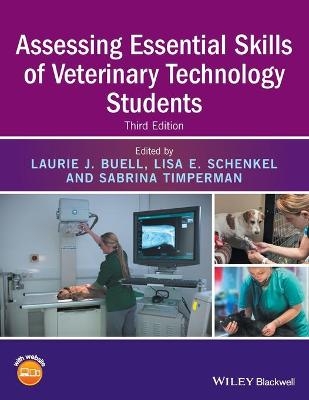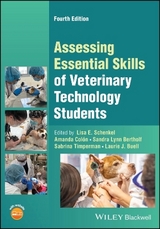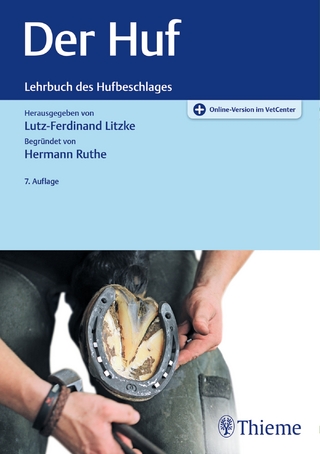
Assessing Essential Skills of Veterinary Technology Students
John Wiley & Sons Inc (Verlag)
978-1-119-04211-2 (ISBN)
- Provides students with clear guidance on the capabilities they are expected to demonstrate and how they will be evaluated
- Gives instructors a standardized framework for assessing students performance
- Offers tools for comparing standards of competency
- Covers management, pharmacology, medical nursing, anesthesia and analgesia, surgical nursing, laboratory procedures, radiography, laboratory animal care, and exotic animal nursing
- Includes access to a companion website with a downloadable log for recording progress
Laurie J. Buell, MS, LVT, is Former Program Director and Former Associate Professor of Veterinary Technology at Mercy College in Dobbs Ferry, New York, USA.
Lisa E. Schenkel, DVM, CCRT, CVMA, is Program Director and Assistant Professor of Veterinary Technology at Mercy College in Dobbs Ferry, New York, USA.
Sabrina Timperman, DVM, is Associate Program Director and Associate Professor of Veterinary Technology at Mercy College in Dobbs Ferry, New York, USA.
Contributors, xiii
Preface, xv
1 Miniature Horses and Ponies 1
DG Pugh, Nicole Passler, and Sara Ziska
1.1 Miniature Horses 1
1.2 General Feeding of Miniature Horses 1
1.3 Pony Feeding 2
References 2
2 Draft Horses, Mules, and Donkeys 5
DG Pugh, Sara Ziska, and Nicole Passler
2.1 Draft Horses 5
2.2 Donkeys 6
2.3 Mules 7
References 7
3 Gastrointestinal System 9
Amelia Munsterman
3.1 The Association between Nutrition and Colic 9
3.1.1 Feeds and Colic: Pastures 9
3.1.2 Feeds and Colic: Dried Forages 10
3.1.3 Feeds and Colic: Concentrates 11
3.1.4 General Practices to Prevent Colic 11
3.2 Nutritional Plans for Horses with Colic 12
3.2.1 Identifying Nutritional Status 12
3.2.2 Nutritional Requirements of Horses with Colic 13
3.3 Routes for Feeding Horses Recovering from Colic 15
3.3.1 Voluntary Intake 15
3.3.2 Supportive Enteral Nutrition 17
3.3.3 Parenteral Nutrition 21
3.4 Diets for Specific Diseases 27
3.4.1 Uncomplicated Colic 27
3.4.2 Equine Gastric Ulcer Syndrome 28
3.4.3 Duodenitis/Proximal Jejunitis 29
3.4.4 Small Intestinal Strangulation 30
3.4.5 Ileal Impaction (Nonstrangulating Small Intestinal Obstruction) 31
3.4.6 Ascending (Large) Colon Impactions 32
3.4.7 Sand Impactions 34
3.4.8 Enteroliths and Fecaliths 35
3.4.9 Ascending Colon Displacement 36
3.4.10 Ascending Colon Volvulus (Large Colon Torsion) 37
3.4.11 Cecal Impactions 39
3.4.12 Cecocecal and Cecocolic Intussusception 39
3.4.13 Descending (Small) Colon Obstructions 40
3.4.14 Descending (Small) Colon Strangulations 41
References 41
4 Muscular System 51
Stephanie J. Valberg
4.1 Myopathies Associated with Nutritional Deficiencies 51
4.1.1 Nutritional Myodegeneration due to Selenium Deficiency 51
4.1.2 Equine Motor Neuron Disease and Vitamin E Deficiency 52
4.1.3 Vitamin E Deficient Myopathy 53
4.1.4 Sporadic Exertional Rhabdomyolysis 54
4.2 Nutrigenomics 55
4.2.1 Chronic Forms of Exertional Rhabdomyolysis 55
4.2.2 Polysaccharide Storage Myopathy 59
4.2.3 Hyperkalemic Periodic Paralysis 66
References 68
5 Endocrine System 73
Iveta Becvarova
5.1 Equine Metabolic Syndrome 73
5.1.1 Definition of Equine Metabolic Syndrome 73
5.1.2 Epidemiology 73
5.1.3 Species, Age, and Sex Predisposition 73
5.1.4 Genetics and Breed Predisposition 73
5.1.5 Risk Factors 74
5.1.6 Geography and Seasonality 74
5.1.7 Associated Conditions and Disorders 74
5.1.8 Clinical Presentation 74
5.1.9 Diagnosis 80
5.1.10 Treatment 82
5.1.11 Possible Complications of Treatment or of the Disease Process 85
5.1.12 Recommended Monitoring 85
5.1.13 Prognosis and Outcome 85
5.1.14 Prevention 85
5.2 Feeding Horses with Pituitary Pars Intermedia Dysfunction 86
5.2.1 Horses with Pituitary Pars Intermedia Dysfunction and Adequate Body Condition 86
5.2.2 Obese Horses with Pituitary Pars Intermedia Dysfunction 87
5.2.3 Horses with Pituitary Pars Intermedia Dysfunction and Thin Body Condition or Horses with PPID that are in Work 87
5.3 Pearls and Considerations 87
5.3.1 Client Education 87
5.3.2 Veterinary Technician Tips 88
References 88
6 Respiratory System 91
Bryan M. Waldridge
6.1 Effects of Inhaled Dust and Potential Aeroallergens on Equine Respiratory Disease 91
6.2 Respirable Dust Deposition in the Airways 91
6.3 Effects of Soaking Hay 93
6.4 Effects of Steam Treating Hay 93
6.5 Feeding Forage Alternatives 93
6.5.1 Haylage 93
6.5.2 Hay Cubes 93
6.5.3 Pellets 95
6.6 Exercise-Induced Pulmonary Hemorrhage 95
6.7 Acute Interstitial Pneumonia 95
References 95
7 Neurologic System 97
Peter Huntington
7.1 Cervical Vertebral Malformation 97
7.2 Botulism 98
7.3 Ryegrass Staggers 99
7.4 Equine Degenerative Myelopathy and Neuroaxonal Dystrophy 99
7.5 Equine Motor Neuron Disease 100
7.6 Effect of Form and Dose of Vitamin E on Serum and Cerebrospinal Fluid Concentrations 101
References 102
8 Mycotoxins 103
Ramesh C. Gupta
8.1 Aflatoxins 103
8.1.1 Toxicokinetics 104
8.1.2 Mechanism of Action 104
8.1.3 Toxicity and Clinical Signs 105
8.1.4 Reproductive and Developmental Effects 105
8.1.5 Treatment 106
8.2 Fumonisins 106
8.2.1 Toxicokinetics 107
8.2.2 Mechanism of Action 107
8.2.3 Toxicity and Clinical Signs 107
8.2.4 Treatment 108
8.3 Slaframine 108
8.3.1 Mechanism of Action 109
8.3.2 Toxicity and Clinical Signs 109
8.3.3 Treatment 109
8.4 Trichothecenes 110
8.4.1 Toxicokinetics 110
8.5 Mechanism of Action 111
8.5.1 Toxicity and Clinical Signs 111
8.5.2 Treatment 112
8.6 Zearalenone 112
8.6.1 Toxicokinetics 113
8.6.2 Mechanism of Action 113
8.6.3 Toxicity and Clinical Signs 113
8.7 Treatment 114
8.8 Concluding Remarks 114
Acknowledgment 114
References 114
9 Poisonous Plants 119
Anthony P. Knight
9.1 Excessive Salivation Induced by Plants 119
9.2 Colic and Diarrhea-Inducing Plants 121
9.2.1 Horse Chestnut or Buckeye 121
9.2.2 Field Bindweed (Morning Glory) 122
9.2.3 Oak 123
9.2.4 Mountain Laurel 124
9.2.5 Pokeweed 125
9.2.6 Buttercups 126
9.2.7 Castor Oil Plant 126
9.2.8 Jimson Weed, Potato, and Tomato 128
9.2.9 Kentucky Coffee Tree 129
9.3 Photodermatitis-Inducing Plants 129
9.3.1 Primary Photosensitization 129
9.3.2 Secondary Photosensitization 131
9.3.3 Liver Disease-Inducing Plants 131
9.4 Neurologic Disease-Inducing Plants 138
9.4.1 Sagebrush 139
9.4.2 Locoweeds and Milkvetches 140
9.4.3 Milkvetch Neurotoxicosis 143
9.4.4 Yellow Star Thistle and Russian Knapweed 143
9.4.5 Horsetail 145
9.4.6 White Snakeroot and Crofton, Jimmy, or Burrow Weeds 145
9.4.7 Bracken Fern 146
9.4.8 Johnsongrass and Sudangrass 147
9.5 Lameness and Muscle Weakness-Inducing Plants 149
9.5.1 Black Walnut 149
9.5.2 Hoary Alyssum 150
9.5.3 Coffee Weed or Coffee Senna 150
9.6 Plant-Induced Calcinosis 151
9.6.1 Day-Blooming Jessamine 152
9.6.2 Flatweed 153
9.7 Selenium Toxicosis 153
9.7.1 Causes of Selenium Toxicosis 154
9.7.2 Two-Grooved Milkvetch (Astragalus bisulcatus) 155
9.7.3 False Golden Weed (Oonopsis species) 155
9.7.4 Woody Aster (Xylorhiza glabriuscula) 155
9.7.5 Prince's Plume (Stanleya pinnata) 155
9.7.6 White Prairie Aster (Aster falcatus) 155
9.7.7 Broom, Turpentine, Snake, or Match Weed (Gutierrezia sarothrae) 156
9.7.8 Gumweed or resinweed (Grindelia spp.) 157
9.7.9 Saltbush (Atriplex spp.) 157
9.7.10 Indian Paintbrush (Castilleja spp.) 157
9.7.11 Beard Tongue (Penstemon spp.) 157
9.7.12 Effects of Acute Selenium Toxicosis 158
9.7.13 Effects of Chronic Selenium Toxicosis 159
9.7.14 Diagnosis of Selenium Toxicosis 160
9.8 Anemia-Inducing Plants 161
9.8.1 Onions 162
9.8.2 Red Maple 162
9.8.3 Spoiled Sweet Clover 163
9.9 Teratogenic Plants 164
9.10 Sudden Death-Inducing Plants 165
9.10.1 Cyanide-Induced Sudden Death 166
9.10.2 Toxicity of Cyanogenic Glycosides 167
9.10.3 Serviceberry or Saskatoon berry (Amelanchier alnifolia) 167
9.10.4 Wild Blue Flax (Linum spp.) 167
9.10.5 Western Chokecherry (Prunus virginiana) 167
9.10.6 Elderberry (Sambuccus spp.) 168
9.10.7 Sorghum Grasses 168
9.10.8 Arrow grass or goose grass (Triglochin spp.) 169
9.10.9 Clinical Effects and Diagnosis of Acute Cyanide Poisoning 169
9.10.10 Treatment of Acute Cyanide Poisoning 170
9.10.11 Cardiac Glycoside-Induced Sudden Death 170
9.11 Larkspur 175
9.12 Monkshood 176
9.13 Poison Hemlock 176
9.14 Water Hemlock 177
9.15 Yew 178
9.16 Death Camas 179
9.17 Avocado 180
Glossary 180
Supplemental Reading 181
References 182
Index 189
| Erscheinungsdatum | 23.04.2017 |
|---|---|
| Verlagsort | New York |
| Sprache | englisch |
| Maße | 216 x 278 mm |
| Gewicht | 302 g |
| Einbandart | kartoniert |
| Themenwelt | Veterinärmedizin ► Allgemein ► Tiermedizinische Fachangestellte |
| Schlagworte | Tiermedizinische Fachangestellte |
| ISBN-10 | 1-119-04211-9 / 1119042119 |
| ISBN-13 | 978-1-119-04211-2 / 9781119042112 |
| Zustand | Neuware |
| Informationen gemäß Produktsicherheitsverordnung (GPSR) | |
| Haben Sie eine Frage zum Produkt? |
aus dem Bereich



